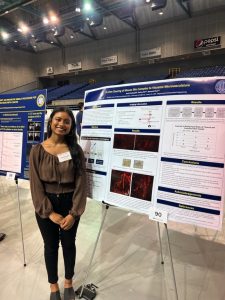Congratulations to Mio Jiang for being offered to participate in the NIA-funded T35 Summer Medical Student Aging and Alzheimer disease Research Training (SMAART) program! Mio, a rising second-year UCI medical student, will continue working with us during the summer on quantitative analysis of our three-dimensional cerebral microvascular maps collected from a preclinical model of Alzheimer’s disease. Congratulations, Mio!
Author Archives: Bernard H Choi
Poster presented by Aarti Dachepalli at the UCI UROP symposium
Kudos to Aarti Dachepalli, an outstanding sophomore in Public Health Sciences, for presenting her research at the 30th anniversary UCI Undergraduate Research Opportunities Program Symposium! Aarti was definitely busy with many conversations with researchers attending the poster session. Great job, Aarti!
New review paper by Dr. Christian Crouzet published in Neurophotonics on wide-field functional imaging of the brain
Download it for free at https://doi.org/10.1117/1.NPh.10.2.020601
Danny Xie will give a virtual poster presentation at the 2022 International Stroke Conference
Danny, a third-year Ph.D. student in the MTI lab, will present his poster entitled “Three-Dimensional Characterization of Cerebral Microvasculature and Microhemorrhages”
Cerebral microhemorrhages (CMH) are small hemorrhages surrounding the brain’s extensive network of blood vessels. They are thought to occur when the integrity of cerebral blood vessels is compromised, leading to deposits of hemosiderin/iron that forms due to the breakdown of red blood cells. The presence of CMH is associated with cognitive decline and ischemic and hemorrhagic stroke. Hypertension is a significant risk factor for cerebral microbleeds. In addition, it has been linked to a more substantial microbleed burden in patients. Despite the clinical significance of hypertension and CMH, our understanding of hypertension-induced microbleed formation remains limited, and the vascular origin of CMH remains obscure. Danny’s work introduces a new technique to image the three-dimensional blood vessel network and the CMH that form in the brain. With these images, he then can use quantitative image analysis to identify the closest vessels nearest to each CMH. His findings suggest that CMH originate from capillary-size vessels in this model of hypertension.
Danny’s ability to perform high-resolution three-dimensional imaging of thick brain specimens is expected to improve our understanding of the vascular origins of CMH. This knowledge can lead to the development of new treatment approaches that reduce the risk of CMH formation.

